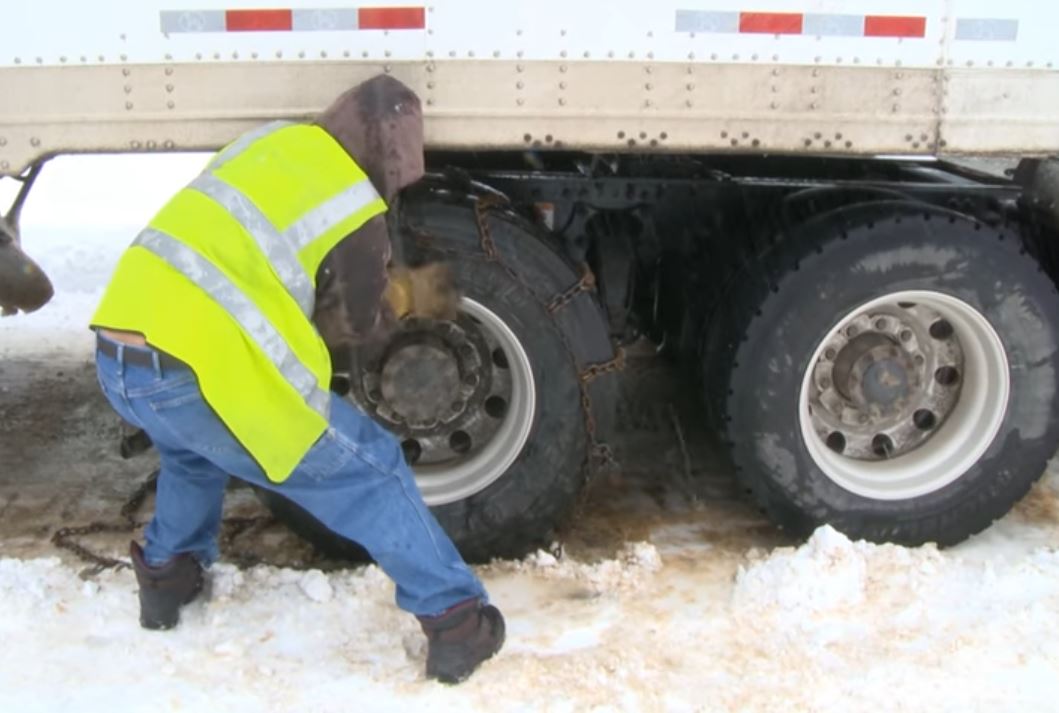
Warning! Don’t let spring play an April Fools’ prank on you.
Roadside signs state passenger vehicles are required to have winter tires, and commercial trucks must carry chains, on most BC highways between October 1 and March 31 (or to April 30, depending on the highway). However, that doesn’t mean winter tires and chains are never needed beyond those dates.
Sometimes spring lets Old Man Winter outstay his welcome, especially on high elevation routes such as the Coquihalla. Professional truck drivers who travel BC’s high mountain passes typically carry chains year-round, and we really appreciate that. By being prepared for the unexpected, these pro drivers contribute to the safety and reliability of our highways.
It’s always best to check DriveBC before you head out. If a late season snow storm strikes, you may want to consider delaying your trip or taking a lower elevation route, if you have already taken your winter tires off or left the chains back at the shop.
… which leads us to the topic of chain-up enforcement on the Coquihalla.
It is so important that commercial vehicles follow chain-up requirements. This is particularly true for the Coquihalla, the province’s busiest mountain pass. We’ve received questions from you about how chain-up regulations are enforced, and what factors are involved in us determining when a mandatory chain-up is needed.
We’ll explain here.
Enforcement
All it takes is a single spun-out commercial truck to block the highway, possibly leading to incidents and delays to all those using the highway. That’s why our Commercial Vehicle Safety and Enforcement (CVSE) officers spend a lot of time enforcing chain-up requirements, especially during Coquihalla Snow Shed Protocol severe weather events (there has been more than 20 of these events this winter!).
During the protocol, CVSE officers mobilize in and around Snow Shed Hill, focusing on chain-up, brake checks, illegal passing of plows and speeding within the variable speed limit zone. From November 2016 through March 2017, CVSE issued 210 violation tickets along the corridor; with 1,000 commercial trucks travelling the Coquihalla every day, this suggests there is generally good compliance from the industry, yet CVSE is at the ready to hold the others into account.
Deciding When Chain-up is Needed
There are many factors we need to consider when deciding whether or not to turn on the mandatory chain up lights for commercial vehicles. Sometimes the decision is easy, other times it is not. If an unchained commercial truck spins out on the hill…easy… it’s a good indication chain-up is required.
But fluctuating weather conditions can make for a tough call.
We often experience transitions from rain to heavy, wet snow along Snow Shed Hill. Although the road may be bare, it often changes to snow at some point before reaching the summit. The heavy snow may not appear significant, but it leads to challenging traction for commercial trucks.
During the Coquihalla Snow Shed Protocol, our maintenance contractor VSA Maintenance is in regular communication with weather forecasters. Activating and deactivating chain-up signs depend on both current and forecasted weather.
Sometimes, we hear from commercial truck drivers who question the need for a chain-up. Although some trucks may not have a problem, others might – there is significant variation in trailer loading, the amount of weight over the drive axles, and the available traction of any given commercial vehicle.
Highway safety is no joke. We choose to take a conservative approach to ensure the safety and reliability of the corridor.
Our listing of current chain-up requirements is a helpful webpage to bookmark. Check it before setting out to cut down on any surprises spring may throw at you.
Join the discussion